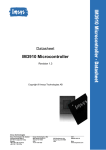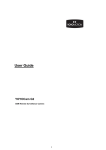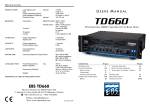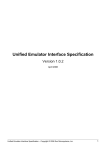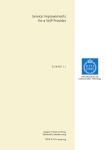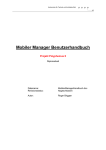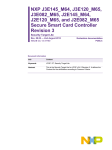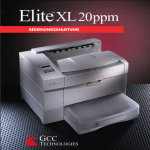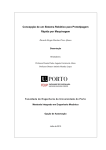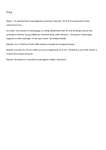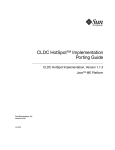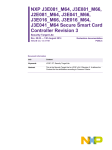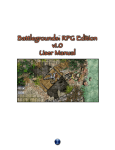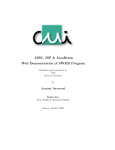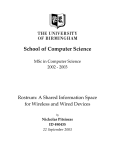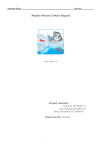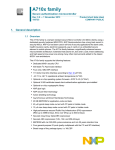Download JAVAAPPLIKATIONER I MOBILA TERMINALER
Transcript
NADA, KTH
Master’s thesis
2002/2003
JAVA APPLICATIONS IN MOBILE DEVICES
- concerning business services at Telia Mobile AB
Author: Mattias Hellström
Supervisor: Henrik Eriksson
Abstract
I have investigated the new Java technology for mobile phones, J2ME (Java 2 Micro Edition),
particularly with respect to the business services Telia Mobile AB offers on the Swedish
market. By studies of J2ME, the GSM network, the GPRS network and Telia Mobile’s
business services in Sweden I have identified some areas where J2ME could ease the usage
and reduce the time to activate features of services. I have also developed an application that
can activate a “Mobile Reference” for a Dirigent subscriber. The application works in a
production environment. I tried to make a similar application that would work with the
equivalent feature for a Centrex subscriber. Unfortunately, due to technical limitations of
J2ME and the limitations of the Java enabled phones on the market today this could not be
done. I have also investigated the possibilities and limitations of J2ME.
Finally, I have come to some conclusions and recommendations for Telia Mobile on how
Telia Mobile should tackle the technology in order to take advantage of it. In the short run I
don’t think the technology will affect the market a lot, the reason being that the technology is
not perfect, that the knowledge about the technology within the business is limited not only
among the customers, but also at big, leading telecom companies, and that most customers do
not have Java enabled mobile phones. However, in the long run I think that this is a
technology that the customers will demand, so Telia Mobile should start to develop strategies
in order to take advantage of the technology. One aspect is the distribution and billing system
of Java applications. I have some proposals that Telia Mobile should look into. As the lack of
knowledge concerning J2ME is extensive among the customers, something should be done to
change the situation. To do that I have some recommendations that hopefully could improve
the knowledge.
Keywords: J2ME, MIDP, CLDC, Dirigent, Centrex, Mobile Switcher
JAVAAPPLIKATIONER I MOBILA TERMINALER
- med avseende på företagstjänster som Telia Mobile AB erbjuder
Sammanfattning
Jag har utrett den nya Javatekniken för mobiltelefoner, J2ME (Java 2 Micro Edition), främst
med avseende på de företagstjänster som Telia Mobile AB erbjuder inom Sverige. Med hjälp
av studier av J2ME, GSM nätet, GPRS nätet och Telia Mobiles företagstjänster i Sverige har
jag identifierat några områden där J2ME skulle kunna förenkla användandet samt minska
tiden det tar att aktivera delar av tjänster. Jag har även utvecklat en applikation som kan
aktivera Dirigents ”Mobil Hänvisning” och som fungerar i skarp miljö. Jag försökte göra en
liknande applikation med samma funktion för Centrexs ”Mobil Hänvisning”, men tekniska
begränsningar i J2ME samt i de mobiltelefoner som finns på marknaden idag gjorde att den
inte fungerade. Jag har även utrett vilka möjligheter samt begränsningar J2ME har.
Avslutningsvis har jag kommit fram till en del rekommendationer om hur Telia Mobile ska
förhålla sig till tekniken för att utnyttja den på bästa sätt. På kort sikt tror jag inte att tekniken
kommer att påverka marknaden nämnvärt. Det beror bland annat på att tekniken inte är
fulländad och att kunskapen om tekniken är begränsad, inte bara bland kunder utan även hos
ledande företag i branschen. Det beror också på att de flesta kunder inte har mobiltelefoner
med Javastöd i. Jag tror dock att det är en teknik som de flesta kunder kommer att ta till sig på
lite längre sikt. Därför bör Telia Mobile lägga upp strategier för att kunna utnyttja teknologin
på bästa sätt. En aspekt är distributionen och betalningsprocessen av Javaapplikationer. Där
har jag några förslag som Telia Mobile borde titta närmare på. Eftersom okunskapen rörande
J2ME är omfattande bland kunderna måste någonting göras för att ändra på det. Jag har några
förslag som förhoppningsvis kan förbättra situationen.
Nyckelord: J2ME, MIDP, CLDC, Dirigent, Centrex, Mobile Switcher
Acknowledgements
This master’s thesis has been written at the departement of Service Design at Telia Mobile
AB for Telia Mobile AB and NADA, KTH. The project has been produced in close
cooperation with MSc student Daniel Hellstrand. My supervisors at Telia Mobile have been
MSc Robert Tjernström and MSc Markus Marklund. My supervisor at KTH has been Doctor
Henrik Eriksson. I would like to thank my supervisors at Telia Mobile and the whole Service
Design department for being supportive and always helping, whenever I had questions. I
learned a lot from them and I really appreciated that they always put away their work to
explain different complex technical problems to me, when I came with a question. It was fun
to go to work and I think the colleagues at the department are of great importance for that. I
will always remember our laughter in the corridor and by the coffee table. I also would like to
thank my enthusiastic supervisor at KTH, Lector Henrik Eriksson for good ideas, which
helped me focus on the important issues. Finally, I would like to thank MSc student Daniel
Hellstrand for interesting and creative discussions and a great support, particularly when it
comes to the implementations. Without these people I would never had come this far.
SUNDSVALL, 2003-02-18
Mattias Hellström
Table of contents
1
BACKGROUND AND PURPOSE ................................................................................ 1
1.1
1.2
1.3
1.4
1.5
2
THEORY ......................................................................................................................... 3
2.1
2.2
2.3
2.4
3
BACKGROUND ........................................................................................................... 1
PURPOSE.................................................................................................................... 1
METHOD.................................................................................................................... 1
OBJECTIVES ............................................................................................................... 2
DELIMITATIONS ......................................................................................................... 2
JAVA ......................................................................................................................... 3
2.1.1
History........................................................................................................ 3
2.1.2 J2ME (Java 2 Micro Edition) ..................................................................... 4
2.1.3
MIDP 1.0, 2.0, CDC and CLDC comparison............................................. 7
2.1.4 MIDP (Mobile Information Device Profile) .............................................. 7
2.1.5 Restrictions within J2ME ........................................................................... 8
2.1.6 Restrictions within MIDP......................................................................... 10
2.1.7
MIDP 1.0.................................................................................................. 10
2.1.8
MIDP 2.0.................................................................................................. 11
2.1.9 Java Servlet Technology .......................................................................... 12
2.1.10 JSP (Java Server Pages Technology) ....................................................... 13
2.1.11 Optional Packages .................................................................................... 13
2.1.12 JSR (Java Specification Request)............................................................. 14
2.1.13 Smart cards............................................................................................... 15
2.1.14 Java CardTM Technology.......................................................................... 15
2.1.15 The Java Card API ................................................................................... 17
2.1.16 Java phones in other countries, distribution of earnings .......................... 17
MOBILE NETWORK .................................................................................................. 18
2.2.1
GSM network with an IN node ................................................................ 18
2.2.2 GPRS (General Packet Radio Service) .................................................... 20
2.2.3 UMTS (Universal Mobile Telecommunications System)........................ 21
2.2.4
USSD (Unstructured Supplementary Service Data) ................................ 21
MOBILE BUSINESS SERVICES.................................................................................... 22
2.3.1
Dirigent..................................................................................................... 22
2.3.2
Centrex ..................................................................................................... 22
VIRUSES .................................................................................................................. 23
2.4.1
Computer viruses...................................................................................... 23
2.4.2
Mobile viruses .......................................................................................... 23
EMPIRY......................................................................................................................... 24
3.1
3.2
MOBILE BUSINESS SERVICES.................................................................................... 24
3.1.1
Dirigent..................................................................................................... 24
3.1.2
Centrex ..................................................................................................... 27
J2ME ...................................................................................................................... 28
3.2.1
USSD........................................................................................................ 28
3.2.2
Servlets ..................................................................................................... 28
4
ANALYSIS AND RECOMMENDATIONS ............................................................... 29
4.1
4.2
4.3
5
CONCLUSIONS AND RECOMMENDATIONS FOR FURTHER STUDIES...... 39
5.1
5.2
6
CONCLUSIONS ......................................................................................................... 39
RECOMMENDATIONS FOR FURTHER STUDIES ........................................................... 39
REFERENCES .............................................................................................................. 40
6.1
6.2
6.3
6.4
7
J2ME ...................................................................................................................... 29
4.1.1
Distribution and billing ............................................................................ 29
4.1.2
Lack of knowledge ................................................................................... 32
4.1.3
Japan......................................................................................................... 33
4.1.4
Development of J2ME and JSR ............................................................... 33
4.1.5
Games....................................................................................................... 33
4.1.6
What APIs are included?.......................................................................... 33
4.1.7
Future services.......................................................................................... 34
4.1.8 USSD and development of new mobile services ..................................... 34
4.1.9 Servlets and JSPs...................................................................................... 34
4.1.10 Java Card Technology.............................................................................. 34
4.1.11 Different applications for different mobile phones .................................. 35
4.1.12 WMA........................................................................................................ 35
4.1.13 MIDP 2.0 and MP3 .................................................................................. 35
4.1.14 Storage space online................................................................................. 35
MOBILE BUSINESS SERVICES.................................................................................... 36
4.2.1
Dirigent..................................................................................................... 36
4.2.2
Centrex ..................................................................................................... 36
SECURITY ................................................................................................................ 36
4.3.1
Trojan horse.............................................................................................. 36
4.3.2
Data erased ............................................................................................... 36
4.3.3
Copying of applications ........................................................................... 37
4.3.4 WAP Gateways ........................................................................................ 38
PRINTED BOOK ........................................................................................................ 40
INTERNET ................................................................................................................ 40
PERSONAL COMMUNICATION ................................................................................... 42
OTHER ..................................................................................................................... 42
APPENDIX .................................................................................................................... 43
1 Background and purpose
1.1 Background
Today there are quite a few mobile devices that support Java applications
(http://www.microjava.com/devices, 2003-02-03) and the number will continue to rise.
The mobile device manufacturers have indicated that a big percentage of the devices of
the future will support the Java technology. Thanks to the integration of mobile
telephony and the Internet it has become possible to download and install small
applications in the mobile devices. This technology can be compared with the
downloading of programs/applications from the Internet to a normal PC. The difference
is only that the applications in the mobile devices are Java applications. These
applications can be independent applications that are being run locally in the mobile
device or alternatively, applications that are being run with a service server. For both
variants one normally has to install them with the help of OTA-technology (Over The
Air). With the new networks, GPRS (General Packet Radio Service) and UMTS
(Universal Mobile Telecommunications System), these mobile devices become more
interesting since the customers can be online constantly and only pay for the data that is
being sent. The Java Technology can be used in existing services by downloading the
adopted applications and installing them in the mobile device in order to facilitate the
use.
1.2 Purpose
The purpose of the master’s thesis is to understand the Java technology, how it can be
used for mobile services and how it can communicate with the existing mobile network
and its interface. A part of the purpose is to get an insight into the supply of services
Telia Mobile AB is offering in the business segment. With this knowledge I will
specify and develop an application that simplifies the use of the business services.
Another part of the purpose is to come up with solutions and proposals that concern the
possibilities and restrictions with Java technology in the mobile network.
1.3 Method
Since the Java Technology for mobile devices is a rather new technology there are not
many books on the market covering neither the theory nor the different implications of
it. Since a big part of my sources has been published on the Internet during the autumn
2002, i.e. at the same time as I have been writing this master’s thesis, I have mostly
used the Internet as information source.
I have searched for information by using Google and AltaVista, sending requests to
persons at many different organizations, mostly other telecom companies, within Telia
Mobile and to Sun Microsystem. The requests have been presented over the phone, by
e-mail and whenever possible between four eyes. To show that the technology can be
used today and that it may actually facilitate usage, I have specified and developed an
application in close cooperation with MSc student Daniel Hellstrand. With support
from the theory and empiry I have come to some conclusions about the Java
Technology in mobile devices and some recommendations to Telia Mobile. The project
has focused on business services since there was a need of this knowledge within Telia
Mobile. However, I have also conclusions concerning Java Technology in mobile
devices in general and Java Technology on the private market.
1
Telia Mobile has supported me with two mobile phones: a Siemens SL45i and a Nokia
7650 (see figure 1), which both support Java. Furthermore, I have been supported with
some different mobile phone subscriptions, a computer and a room at the Service
Design Department.
Figure 1. Nokia 7650
(http://www.nokia.se/mobiltelefoner/7650/#, 2003-02-03)
1.4 Objectives
The objectives of the master’s project are:
•
•
•
•
•
Understand how the Java technology can be used in mobile devices
Present one or two services where Java applications could make the service
easier to use and available for more customers
Specify the functionality of the application and the effect on the mobile network
Realize an application and test it on an appropriate business customer
Investigate the possibilities and limitations with Java for mobile devices and
specifically what it means for Telia Mobile
1.5 Delimitations
I have decided to delimit the master’s project to the Java technology. I could have
examined competing technologies, such as Symbian and other operating systems, and
compared them to Java, but that lies outside of my project specification. I have also
concentrated on the Java technology for mobile phones and not PDAs since most
people have a mobile phone, but not a PDA.
2
2 Theory
The Java technology is first presented and then the mobile network GSM, the Intelligent
Node, IN, and the GPRS network are described. Some business mobile services at Telia
Mobile AB are then being introduced. Finally, the security aspect is covered with some
former experiences.
2.1 Java
2.1.1 History
It all started 1991 when Patrick Naughton, Mike Sheridan and James Gosling started to
create something that was supposed to be a programming tool at Sun. Creating a new
language was never the goal. The secret “Green Team” consisting of 13 people had a
conclusion saying that the convergence of digitally controlled consumer devices and
computers would become a significant trend in the industry. With that in mind they
created an interactive, handheld home entertainment device controller with an animated
touch screen user interface. Since it ran on an entirely new processor-independent
language it was able to control a wide range of entertainment platforms and appliances,
while displaying animation. Green Team member James Gosling created the language
specifically for the demo. He first called the language “Oak” after a tree outside his
window. The whole project started involving potential customers in the cable television
industry and the Green Team developed a new demo called MovieWood. It was
interactive so that users could read and write information into the system. However, the
companies in the cable television business did not want to lose that much control. Sun
then realized that there was not a business in digital cable
television.(http://java.sun.com/features/1998/05/birthday.html, 2002-09-25)
At a group meeting with Gosling and five other important persons from Sun they come
up with the idea: “Why not the Internet?” Internet was becoming popular and it was
exactly the type of network configuration that the former Green Team had envisioned
for the cable TV industry. In fact, the Internet was being transformed into exactly the
network that the Green Team had been trying to convince the cable companies they
ought to be building. “It was just an incredible accident and it was patently obvious that
the Internet and Java were a match made in heaven” according to Gosling. 1994 the
team produced the HotJavaTM browser, which for the first time brought to life animated,
moving objects and dynamic executable content inside a Web browser. Later on, to be
more precise early in 1995, these features were demonstrated to Internet and
entertainment professionals at the Technology, Entertainment and Design Conference
in Monterey. The audience was amazed by the new technology and the rumours about
the new technology spread quickly. One month after the Conference in Monterey
Goslings’ group was ready to make the binary code available and free over the Internet.
By March 1995 the number of binary copies outside Sun was only seven or eight, but
just in a few months, the downloads began to surge into thousands. Gosling had set up a
goal that stated that if they reached 10 000 downloads it would be “a total, blow-thedoors-off success”. This goal was reached even faster then Gosling in his wildest
dreams ever could imagine. With marketing and a front-page story in San Jose Mercury
News, the downloading continued. (Byouns, 1998)
3
Figure 2. The front-page of San Jose Mercury News, March 23, 1995.
(http://java.sun.com/features/1998/05/birthday.html, 2002-09-25)
According to David Bank Sun gave away Java and HotJava free for non-commercial
use in a fast-track attempt to make them the standard before Microsoft began shipping a
similar product, codenamed Blackbird, in early 1996 (Bank, 1995). Since many
synergetic effects have hit the Internet and enterprise technology the last years the
development of the technology has accelerated. Examples of appearances at the market
that have created synergic effects are: applets, thousands of Java technology-oriented
start-ups, over a thousand books on Java technology, Netscape Communicator,
thousands of Internet service providers, 60 million Internet users, 56K and cable
modems, electronic commerce and commitments from major players such as IBM. The
synergetic effects have also helped the Java platform to become adopted quickly in the
industry. (Byouns, 1998) Any Java application can be downloaded over any network
and installed without operating system or hardware platform compatibility issues.
(http://java.sun.com/java2/whatis/, 2002-09-26) It was during another group meeting at
Sun another question maybe popped up: “Why not mobile devices?” One reason why
Java is a good language to develop is that many software developers know the Java
language well and the increase of bandwidth in mobile networks will enable new
mobile services. Sun therefore developed a Java version for mobile devices. In fact,
today, September 2002, there are a number of mobile phones containing the Java
platform on the market.
2.1.2 J2ME (Java 2 Micro Edition)
Because of limited resources in mobile devices in terms of limited displays for instance
it is not possible to install the entire J2SE (Java 2 Standard Edition) Application
Programming Interface (API) on a small device. That is the reason why “Micro
Edition” was developed.(Muchow,2002) The idea with J2ME is to enable the customer
to download applications to the mobile phone and to increase customer value with
these applications.
J2ME stands for JavaTM Platform, Micro Edition and is a very small Java application
environment. It can be configured for a variety of market segments.
(http://java.sun.com/j2me/j2me-ds-0201.pdf, 2002-09-26) However, J2ME is aimed at
consumer devices with limited horsepower. Many of these devices (e.g. mobile phones
and PDAs) do not have the option of downloading and installing beyond what was
configured during the manufacturing process. With J2ME the small devices no more
need to be “static” in nature.
4
A configuration comprises a virtual machine, core libraries, classes and APIs.
Currently, there exist two different configurations: the Connected Limited Device
Configuration (CLDC) and the Connected Device Configuration (CDC). CLDC is used
for devices with constrained CPU (Central Processor Unit) and memory resources, such
as mobile phones and PDAs. CDC is designed for the next-generation devices with
more robust resources. The advantages with J2ME are that it will be simple for the
customers to use, simple for the programmers to develop and also simple for service
providers to deploy. (http://java.sun.com/j2me/j2me-ds-0201.pdf, 2002-09-26)
Examples of downloadable applications can be interactive games, life management
tools, travel-related applications and information tools. Applications could for instance
have a zoomable map needed on a business trip and when the application no longer is
needed, the user can simply delete it from the memory.
(http://www.nokia.com/java/for_developers.html, 2002-10-15)
Figure 3. Difference between CLDC and CDC and virtual machines
(http://www.fawcette.com/javapro/2002_12/magazine/features/dhemphill/default_pf.as
p)
CDC (Connected Device Configuration)
CDC is designed for the next-generation devices with more robust resources. These
devices typically run on a 32-bit CPU and have 2 Mbytes or more memory available for
the Java platform and its applications. (http://java.sun.com/j2me/j2me-ds-0201.pdf,
2002-09-26)
5
The characteristics of the devices that use CDC are:
• 512 kilobytes (minimum) memory for running Java
• 256 kilobytes (minimum) for runtime memory allocation
• Network connectivity, possibly persistent and high bandwidth
(Muchow, 2002)
CLDC (Connected Limited Device Configuration)
CLDC is the foundation of the Java runtime environment targeting small, resourceconstrained devices, such as mobile phones and PDAs. To support the CLDC there are
two virtual machines that can be used, the K Virtual Machine (KVM) and the CLDC
HotSpot virtual machine. K is referring to kilobyte because the virtual machine only
demands a few tens of kilobyte of memory when executing. The KVM is designed with
the constraints of inexpensive mobile devices in mind. CLDC with KVM is suitable for
devices with 16/32-bit RISC/CISC microprocessors/controllers. It only has 160 KB of
total memory available for the Java technology stack. Of these 160KB, 128KB is used
for the storage of actual virtual machine and libraries and the remainder is for Java
applications. The CLDC HotSpot virtual machine is targeted for mobile devices with
bigger resources. The implementation of the latter virtual machine is suitable for
devices with 32-bit RISC/CISC microprocessors/controllers and with 512kB to 1MB of
total memory available for the Java stack, including applications.
(http://java.sun.com/products/cldc/, 2002-09-26)
J2SE
CDC
CLDC
Figure 4. This figure represents how the different configurations are inherited from
each other. (J2SE - Java 2 Standard Edition)
At the wireless market the utilizing of CLDC can retain a very small footprint, consume
little power and provide as much capability as is needed for handheld devices.
(http://java.sun.com/j2me/j2me-ds-0201.pdf, 2002-09-26)
The characteristics of the devices that use CLDC are:
•
•
•
128 kilobytes memory for running Java
32 kilobytes memory for runtime memory allocation
Restricted user interface
6
•
•
Low power, typically battery powered
Network connectivity, typically wireless, with low bandwidth and
intermittent access
(Muchow, 2002)
2.1.3 MIDP 1.0, 2.0, CDC and CLDC comparison
The picture below illustrates the different parts of Java, and in which manner they are
related.
Figure 5. This show from what source the different configurations and profiles have
sprung. (http://wireless.java.sun.com/getstart/articles/survey/survey_fig1.gif, 2003-0130)
2.1.4 MIDP (Mobile Information Device Profile)
Mobile Information Device Profile, MIDP, is a part of the J2ME and defines the JavaTM
application environment for mobile information devices (MIDs). MIDlet is an
application that runs in the MIDP environment. If one or more MIDlets are packaged
together for distribution they are called a MIDlet suite.
To show the similarities and differences between MIDP 1.0, MIDP 2.0, CDC 1.0,
CLDC 1.0 and CLDC 1.1 I have included a table as appendix. It contains a list of the
Core Java Packages and it shows which packages are included in which
configuration/profile.
7
Games
Stock information
Figure 6. Examples of J2ME applications
(http://www.sumea.com/6_0/games.html, 2003-01-30; http://ewww.motorola.com/webapp/sps/site/application.jsp?nodeId=03M0ym4sDZxM0zbxntsZ
, 2003-01-30)
2.1.5
Restrictions within J2ME
Java language differences
There are three main areas that distinguish the Java language for CLDC versus the Java
Language Specification.
Floating point math is intrinsic processor intensive. It is also a fact that the majority of
devices will not have special hardware for handling float point numbers. Therefore the
CLDC implementation of the Java language does not support floats. This lack of
support is carried throughout all Java code one writes. One cannot use float variables,
constants, arrays and arithmetic or return values from methods.
Within a J2SE class, one can declare a method with the name finalize(). Finalization is
a method that will be called before the garbage collector frees the object. Although the
garbage collector frees memory used by an object, it is not aware of system resources
that may have been acquired. The finalize() method is where one can place code to
clean up allocated resources. Unfortunately, the finalize method is not supported in the
CLDC. The reason is to find in the specification, but it is a bit sketchy. However, one
can make a safe assumption and that is that the overhead and/or processor requirements
are too steep.
8
The KVM (K Virtual Machine) supports a limited set of error handling exceptions.
There are two reasons for that:
•
Since the exception handling in J2SE is quite comprehensive it takes a
significant demand on the system, which the CLDC cannot meet.
•
Often times, embedded systems provide their own internal error handling. When
the problem has come so far it’s too late for the developer to deal with it. A
simple solution for the most serious errors is to shut off the device. However,
this way of solving the problem is definitely not convenient for the user and is
more appropriate in a hardware point of view.
Java Virtual Machine Differences
The K Virtual Machine, KVM, differs from the Java Language Specification as
follows:
Floating Point Math
The implementation of the Java language for CLDC lacks support for floating point
numbers, as mentioned above.
Java Native Interface
In order to meet the goals of reduced memory requirements and to reduce the potential
of corruption to system level information support for invoking native methods and APIs
of other programming languages was eliminated. However, a KVM-implementation
may link native code directly into the virtual machine. Unfortunately, an application
that accesses the native code may not be portable to other KVMs.
Custom Class Loader
The VM is required by the CLDC to implement a class loader. This loader is being
controlled tightly – it can’t be replaced, overridden or modified. It is device-dependent,
i.e. defined and implemented by the device manufacturer, and it includes how classes
are loaded and in what manner error conditions are handled.
Reflection
One can use reflection in J2SE to get information about the running VM. This may
include information about the class files loaded and their methods and fields.
Unfortunately, reflection is not included in the KVM.
Thread Groups
For Thread Groups implementation, threads are processed on an object-by-object basis.
The Thread Group class is not supported in the KVM. Thus, one cannot perform
operations such as starting/stopping a group of threads through one method call. To
solve this problem and mimic the functionality one can roll one’s own thread
processing code, e.g. by storing a group of threads objects within a collection class and
to provide methods to start/stop all objects within the collection.
9
Finalization
The implementation of the Java language for CLDC lacks support for finalization, as
mentioned above. This is also a fact for the KVM.
Weak Reference
The so-called Weak Reference to objects is allowed in J2SE. This means that the
garbage collector recognizes that an object is being referenced and the object is still a
candidate for garbage collection. Weak References is not supported in the KVM.
Handling security
All devices that are running a Java application need to be protected from malicious
code (intentional or otherwise) that may access system information or resources.
Regardless of the JVM, this type of “low-level” security is implemented with the use of
class file verification. The JVM verifies all classes in class loaders and ensures that
applications do not perform any dangerous operations. Since the verification at runtime
is computationally expensive for MIDP VMs, MIDP uses a two-stage bytecode
verification model. MIDP VMs do not perform complete bytecode verification at
runtime. Instead the application developers have to run a pre-verification of the classes
on a development platform before deploying the application. The pre-verification
process optimizes the execution flows, creates stackmaps containing catalogs of
instructions in the application, and then adds the stackmaps to the pre-verified class
files. At runtime, the MIDP VM does a quick linear scan of the bytecode, matching
each valid instruction with a proper stackmap entry. Since MIDP lacks a complete
security model some J2SE features are disabled in J2ME that otherwise would pose a
security risk. As an example it is a fact that user-defined class-loaders are not allowed,
to prevent illegal overloading of core classes.
(http://www-106.ibm.com/developerworks/webservices/library/wisecj2me.html?dwzone=webservices, 2003-01-29)
2.1.6 Restrictions within MIDP
LCDUI (Liquid Crystal Display User Interface) does not provide overlapping windows
for MIDP.
Unfortunately, some APIs are not included within MIDP, but included by specific
mobile phone producers. Siemens have APIs for calling, SMS and phonebook
(restricted). Nokia has an extra API supporting SMS for their phones. Motorola has an
UI API and an API for Bluetooth. Only the corresponding manufacturer supports the
extra API. Ericsson and Samsung do not have any extra APIs at all.
2.1.7 MIDP 1.0
MIDP 1.0 is the first version of MIDP and therefore it does not supply the developers
with all desired API’s. It provides standard APIs for application lifecycle, HTTP
network connectivity, user interface, and persistent storage. However, SMS (Short
Message Service), CBS (Cell Broadcast Service) and USSD (Unstructured
Supplementary Service Data) are not supported. Cell Broadcast permits
unacknowledged text messages to be broadcast to all receivers within a particular
region (http://www.etsi.org/, 2003-01-08). USSD is a type of signalling.
10
2.1.8 MIDP 2.0
Specification process
During the specification process indications were given that USSD was to be supported
in MIDP 2.0 or in the JSR 118 (Java Specification Request), also known as WMA
(Wireless Messaging API). WMA includes APIs for SMS and CBS and the mobile
phone manufacturers choose to support it or not in the phones. Actually, in the first
draft of WMA, USSD was supported. However, support for USSD was finally rejected
both in MIDP 2.0 and in the WMA-package.
The final draft of MIDP 2.0 was published in November 2002 and includes many
enhancements and additions to MIDP 1.0. Estimates in December 2002 are that MIDP
2.0 devices will be available in large volumes in summer 2003. The enhancements
included cover the following areas:
•
•
•
•
•
•
Secure networking
Multimedia
Form Enhancements
The Game API
RGB Images
Code Signing and Permissions
Secure Networking
MIDP 2.0 not only supplies HTTP connections, but also HTTPS connections.
Basically, HTTPS is a HTTP over the Secure Sockets Layer (SSL), which is a socket
protocol. It encrypts data sent over the network and provides authentication for the
socket endpoints. MIDP 1.0 implementations can support HTTPS, but one cannot rely
on its availability. What MIDP 2.0 does is to provide a stable, consistent foundation for
wireless applications that deal with money or sensitive information. The CLDC’s
Generic Connection Framework in the javax.microedition.io package provides HTTPS
support. The two following examples show how easy it is to construct a HTTP and a
HTTPS connection:
HTTP connection:
String url =”http://www.cert.org/”;
HttpConnection hc = (Httpconnection)Connector.open(url);
HTTPS connection:
String url =”https://www.cert.org/”;
HttpsConnection hc = (Httpsconnection)Connector.open(url);
“Javax.microedition.io.SecurityInfo” can be used to retrieve the certificate, protocol,
version, and cipher suite used by a HTTP connection, and
“javax.microedition.pki.Certificate” represents a cryptographic certificate. They are
both included in MIDP 2.0.
Multimedia
MIDP 2.0 has mobile media APIs that support playback of sampled audio.
Implementations using these APIs must be able to play WAV files and are free to
support additional audio formats.
11
There have been some changes in javax.microedition.lcdui. The form layout is
considerably more sophisticated than it is in MIDP 1.0. Items are laid out like ordinary
text left to right in rows that stack from top to bottom and one can modify this layout.
The Game API
Many of the enhancements for game developers can be found in
javax.microedition.lcdui.game. There are five classes in the Game API that extends
MIDP’s graphics capabilities. Contents of the screen can be composed of different
layers where one layer could for example be the background. A second layer could be a
spaceship and a third a clouds, rain, etc.
RGB Images
With the MIDP 2.0 it is possible to represent an image as integer arrays, which allows
MIDlets to manipulate image data directly.
(http://wireless.java.sun.com/midp/articles/midp20/, 2003-01-08)
2.1.9 Java Servlet Technology
Java Servlet Technlogy enables web developers to extend the functionality of a web
server. A servlet can be thought of as an applet that runs on the server side and
therefore servlets have made many web applications possible. Servlets provide a
component-based, platform-independent method for building web-based applications,
without the performance limitations of the CGI (Common Gateway Interface) programs
(similar as servlets). (http://java.sun.com/products/servlet/, 2002-11-05)
A servlet is a file written in Java, which then is compiled with for example Javac,
which is a Java compiler. When the class (the servlet) is called from a file (HTML, JSP
or WML) it is run through the JVM loaded on the server. One needs servlets to be able
to build dynamic web pages and connect mobile phones to databases. One can use CGI
instead of servlets but since servlets have several advantages (listed below) they are
preferred.
•
Effectiveness. With regular CGI a new process is started for every HTTP
request, and if the CGI program itself is small and fast the majority of the
consumed time might be starting the process. With servlets the JVM stays up
and each request is handled by a lightweight Java thread, which is much more
efficient while one doesn’t have to start a new session for each thread. Another
advantage is that if there are n simultaneous request to the same CGI program,
the code of the CGI program is loaded into memory n times. With a servlet
there are n threads but only one servlet class loaded into the memory.
•
Powerfulness. Servlets can do things that are difficult or maybe impossible
with CGI. They can talk directly to a web server and thereby the process of
getting pictures and other stored data is simplified. They can share data between
them, which makes it easier to implement database connection pools. They can
maintain information from request to request, simplifying session tracking and
caching of previous computations.
•
Portability. Since servlets are written in Java they are supported on basically
every major web server, generally without any changes made to the code.
12
2.1.10 JSP (Java Server Pages Technology)
Java Server Pages (JSP) technology allows one to create web content easily from both
static and dynamic components. JSP technology supports all the dynamic capabilities of
Java Servlet technology but provides a more natural approach to creating static content.
The main features of JSP technology are:
•
•
•
A language for developing JSP pages, which are text-based documents and
describe how to process a request and construct a response
Constructs for accessing server-side objects
Mechanisms for defining extensions to the JSP language
A JSP page is a text-based document that contains two types of text: Static template
data, which can be expressed in any text based format, such as HTML SVG, WML and
XML and JSP elements, which construct dynamic contents. A JSP page handles
requests as a servlet. Thus, the life cycle and many of the capabilities of JSP pages (in
particular the dynamic aspects) are determined by the Java Servlet technology. When a
request is mapped to a JSP, it is first handled by a special servlet that checks whether
the JSP page’s servlet is older than the JSP page. If it is older, it translates the JSP page
into a servlet class and compiles the class. One of the advantages of JSP pages over
servlets is that the build process is performed automatically.
(http://java.sun.com/webservices/docs/1.0/tutorial/doc/JSPIntro.html, 2002-11-05)
2.1.11 Optional Packages
In the early development of J2ME the focus was on developing configurations and
profiles but as time passed they realized that something else was needed, Optional
Packages. Optional Packages are similar to profiles also a set of APIs but unlike
profiles they do not define a complete application environment. An optional package is
always used in conjunction with a configuration or a profile. The optional packages
give developers access to additional functions of the devices and since these specific
capabilities are not universal for all devices, the manufacturers can choose to preload
whichever profiles and optional packages they see fit to their devices. Note that a
package normally has to be preloaded onto a device, as part of the runtime
environment, by the manufacturer, for developers to be able to use them. If one would
try to use an optional package without it being preloaded, it simply wouldn’t work;
there would be no support for the classes. Because just like profiles and configurations,
optional packages are specified through the Java Community Process, each has its own
reference implementation (RI) and test compatibility toolkit (TCK). Besides aiding the
vendors in implementing optional packages as part of their runtime environments, the
RI and TCK also ensure that those implementations are done consistently and correctly,
no matter which device that is being used. It usually takes some time after an optional
package specification has been finalized before implementation appear on commercial
devices.
Some examples of optional packages are: JSR 66: RMI Optional Package, JSR 120:
Wireless Messaging API, JSR 135: Mobile Media API, JSR 169: JDBC for CDC/FP.
(http://wireless.java.sun.com/midp/articles/optional/ 2002-12-18)
13
Bluetooth
Bluetooth is an important emerging standard for wireless integration of small devices.
The specification is labelled JSR82, and it is now in JCP Final Release Stage. The
JSR82 specification will standardize a set of Java APIs to allow the Java-enabled
devices to integrate into a Bluetooth environment.
The specification will include basic support for, at least, the following Bluetooth
protocols: RFCOMM, OBEX, and Service Discovery protocols. Additional protocol
support may be added in future versions. The specification is primarily targeted at
native Bluetooth protocols.
The Java APIs for Bluetooth are targeted at devices characterized as follows:
• 512 K minimum total memory available (ROM/Flash and RAM). Application
memory requirements are additional.
• Bluetooth network connection.
• Compliant implementation of the J2ME Connected Limited Device
Configuration.
The specification will define the APIs such that it will be extensible to other Bluetooth
protocols which exist today (i.e. Home RF), or that might come about in the future. In
addition, the APIs will be specified in a way to allow layering for more capable Java
platforms such as the CDC, J2SE, and J2EE. (http://www.jcp.org/en/jsr/detail?id=82,
2003-01-20)
2.1.12 JSR (Java Specification Request)
JSR stands for Java Specification Request and they are the actual descriptions of
proposed and final specifications for the Java platform. There are six stages a proposal
has to go through:
1. JSR Review - A specification is initiated by community members and approved
for development by the Executive Committee
2. Community Review - Once a JSR is approved, a group of experts is formed to
develop a first draft of the specification that both the community and the
Executive Committee review.
3. Public Review - The JSR draft goes out for review by the public where anyone
with an Internet connection can read and comment on the draft. The Expert
Group uses the public feedback to further revise the document.
4. Proposed Final Draft - The version of the draft specification that will be used as
the basis for the RI and TCK.
5. Final Release - The leader of the Expert Group then sees that the reference
implementation and its associated Technology Compatibility Kit are completed
before sending the specification to the Executive Committee for final approval.
6. Maintenance Review - The completed specification, reference implementation,
and Technology Compatibility Kit are updated in response to ongoing requests
for clarification, interpretation, enhancements, and revisions.
(http://www.jcp.org/en/jsr/stage, 2002-11-20)
To point out how long time it takes for a proposal to go through this chain, I will use
JSR82 (bluetooth) as an example. From start to finish, JSR 82 took nearly one and a
14
half years to finish. The Executive Committee approved its proposal October 2000. The
original 14-member expert group took shape the next month, and seven additional
members were appointed in July 2001. The community reviewed the specification in
November, with public review following in December, and the final draft was proposed
in January. On March 4, 2002, the Executive Committee approved the final
specification. (http://www.jcp.org/en/press/success/bluetooth, 2003-01-20)
2.1.13 Smart cards
A smart card is a card with embedded chips, either a microprocessor and a memory
chip or only a memory chip with a non-programmable logic. The microprocessor card
can add, delete, and otherwise manipulate information on the card, e.g. a Java program.
A memory-chip card (for example, pre-paid phone cards) can only undertake a predefined operation.
Smart cards, unlike magnetic stripe cards, can carry all necessary functions and
information on the card, e.g. for a transaction. Therefore, they don’t require access to
remote databases at the time of the transaction.
2.1.14 Java CardTM Technology
Java CardTM Technology enables smart cards and other devices with limited memory
resources to run small applications, called applets, which utilize JavaTM Technology.
Java Card Technology offers platform independence, the ability to store and update
multiple applications, and compatibility with existing smart card standards.
A complementary technology is Java 2 Platform, Micro Edition. The two technologies
make it easy to integrate essential consumer technology into a complete Java software
solution. New applications and services can be rapidly and securely built, tested, and
deployed. This reduces development costs, adds product differentiation and enhances
value-add for customers.
Industries Embracing the Java Card
Most smart cards can be fitted with Java Card technology, including:
•
•
•
SIM cards used in cell phones on most second and third generation wireless
networks
Financial cards providing both online and offline transactions
Government ID cards
On the majority of cellular telephone networks, smart cards (SIM cards) are required to
activate the telephone. The SIM card authenticates the user and provides encryption
keys for digital voice transmission. If fitted with Java Card technology, SIM cards can
also provide transactional services such as remote banking and ticketing.
In the banking industry, smart cards can give users secure access to a wide array of
networked financial services including cash machines, bill paying, and bridge tolls.
Java Card-based smart cards can host multiple financial applications in a single smart
card and deliver third-party services such as mileage programs or secure, on-line
trading.
A wide variety of other applications are available wherever security and authenticated
identity are important. Examples of services are providing access to facilities and
medical records.
15
Java Card technology will enhance consumer access to new, e-commerce services
through a number of connected appliances. Examples of markets where the majority of
products now available include built-in smart cards are cellular phones and pay-TV
equipment.
Advantages of Developing with Java Card
The Java Card technology offers all the advantages of developing applications in the
Java programming language:
•
•
•
•
High programmer productivity
Object-oriented programming with greater code modularity and reusability
Java language protections apply to Java Card applets, enforcing strong typing
and protection attributes
Availability of powerful off-the-shelf development tools
Components of Java Card Technology
The Java Card technology consists of the Java Card specifications and the Java Card
Development Kit, which includes a reference implementation based on those
specifications.
Providing the basis for cross-platform and cross-vendor applet interoperability, the Java
Card specifications are as follows:
•
•
•
Java Card 2.2 Virtual Machine Specification, Revision 1.0, Sun Microsystems,
Inc.
Java Card 2.2 Runtime Environment (JCRE) Specification, Revision 1.0, Sun
Microsystems, Inc.
Java Card 2.2 API Specification, Revision 1.1, Sun Microsystems, Inc.
Java Card Virtual Machine (JCVM) Specification
The Java Card 2.2 Virtual Machine Specification defines the features, services, and
behaviour that are required of an implementation of the Java Card technology. It
includes the instruction set of a Java Card virtual machine and the supported subset of
the Java language. It also includes file formats used for installing applets and libraries
into devices, like smart cards, which implement Java Card technology.
Java Card Runtime Environment (JCRE) Specification
The JCRE 2.2 Specification complements the Java Card 2.2 API Specification and
defines the necessary behaviour of the runtime environment in any implementation of
the Java Card technology. An implementation of the Java Card Virtual Machine is
included in such implementation. The Java Card Application Programming Interface
(API) classes, and runtime supports services such as the selection of applets are also
included.
Java Card API Specification
The Java Card API is compatible with formal international standards and industryspecific standards and it contains the class definitions required to support the JCVM
and the JCRE.
Java Card Development Kit
The Java Card Development Kit is a suite of tools for designing Java Card technology-
16
based implementations and developing applets based on the Java Card API
Specification. It consists of:
•
•
•
The C-JCRE is a reference implementation of the Java Card Runtime
Environment written in the C programming language. The C-JCRE also
includes the Java Card Virtual Machine (JCVM) interpreter.
Off-card platform components such as the Java Card Converter and the Java
Card Verifier complement the C-JCRE to provide a complete development
chain.
Additional design and testing tools enable developers to prototype and test Java
Card applications.
Java Card Technology Licensees
Java Card technology is licensed to smart card manufacturers representing more than
90 percent of the world’s smart card manufacturing market. The platform that is
defined by the Java Card technology provides a range of new opportunities for original
equipment manufacturers (OEMs) and their partners across multiple industries. The
GSM (Global System for Mobile communications) cellular telephone industry is an
example of a large, global market for smart cards based on Java Card technology.
Major financial institutions are deploying Java Card technology to provide a rich set of
applications in a single card.
(http://java.sun.com/products/javacard/datasheet.html/, 2002-11-13)
2.1.15 The Java Card API
The APIs included for security are:
•
•
•
•
•
•
AES Key
DES Key (Triple DES supported)
DAS Key
EC Key
RSA Private Key
RSA Public Key
Therefore, very sophisticated cryptographic solutions for secure mobile connections
can be obtained with the Java Card Technology.
2.1.16 Java phones in other countries, distribution of earnings
In Japan Java phones have been available on the market the last couple of years. The
Japanese mobile operator NTT Docomo’s revenues from customers with Java phones
are more than double compared to the other customers. In Korea the mobile operator
LG Telecom makes approximately 50 SEK per month more on customers with Java
enable phones than on the other customers. They are doing this even though the Java
programs are very simple. According to Rikard Kjellberg, Technology Manager at
Ellipsus AB, one of the reasons is that Japanese customers appreciate a figure just
jumping up and down on the display, but the customers in Europe are not willing to pay
for that. (http://www.nyteknik.se/pub/ipsart.asp?art_id=20050, 2002-12-16)
17
2.2 Mobile Network
The different parts of an IN (Intelligent network), the GSM network (Global System for
Mobile communications) and the GPRS network (General Packet Radio Service) are
presented in figure 7.
EIR
VLR
IN
GMSC
HLR
AUC
Other
networks
MSC
BSC
GGSN
Backbone
SGSN
MS
PCU
BTS
GSM network
GPRS network
Figure 7. This is a modified version from GSM System Overview, APIS Training &
Seminars and GPRS Protocols and Procedures, Enea Epact.
2.2.1
GSM network with an IN node
Mobile Station (MS)
The MS is nothing else but the SIM, “Subscriber Identity Module”, and the ”Mobile
Equipment” (ME). The SIM is a separate physical entity that contains all information
regarding the subscription. It is an IC-card, or a “smart card”. The Mobile Equipment is
the actual piece of hardware enabling radio communication with the system. Without a
SIM the Mobile Equipment cannot be used in the GSM network, except for emergency
18
Internet
calls. The SIM can be put into different mobile equipment and then all calls are routed
to that mobile equipment.
Base Station Systems
Base Transceiver Station (BTS)
This is the radio part of the system. The main task is communication on radio with the
MS:s. Each BTS covers a cell with transmitted radio waves. The BTS contains all radio
equipment necessary to stay in touch with the MS.
Base Station Controller (BSC)
The BSC controls and supervises all underlying BTS:s. The BTS takes care of the
actual radio communication and the BSC is in charge of all action that is taken. That
means that the BSC tells the BTS:s what to do, when to transmit, what power to use,
etc.
Switching System
Mobile services Switching Centre (MSC)
The MSC sets up, supervises and releases calls. It can connect calls within the GSM
network, between a mobile subscriber and a subscriber in the PSTN (Public Switched
Telephone Network) or in other networks.
IN
IN (Intelligent network) is, according to ETSI (European Telecommunications
Standards Institute), an architect concept for all telecommunication networks, which
aims to ease the introduction of additional services. An IN service is for example prepaid, Dirigent Centrex or Mobile Switcher. A number is first dialled on the MS. When
the send-button is pressed, the call will be set up, via the BTS, onwards to the BSC and
finally to the MSC. The MSC then analyses the digits dialled and sets up the call to
wherever it is to go. If the subscriber is having an IN service the call is then transmitted
to the IN node. The IN node then executes the call request depending on which type of
subscription that is calling. If a Pre-paid customer is calling the IN node checks whether
the subscriber has enough credits to make a phone call before the call is being set up. If
the customer is a Dirigent subscriber and uses an extension number within his/her
groups, then the IN node translates for instance the extension number 52 23 into the
mobile public number 070 684 52 23. After the translation the call is being forwarded
in the GSM network. In this case it would be forwarded to the GMSC.
Gateway Mobile services Switching Centre (GMSC)
It is necessary to have a gateway between GSM and other networks. A call to a
subscriber in the GSM network means that the call will first be routed to the GMSC.
The responsibility of the GMSC is then to find out what part of the GSM network the
MS is situated by questioning HLR (Home Location Register) and also for routing the
call there.
Home Location Register (HLR)
The HLR is a global database that keeps track of where the subscriber approximately is.
Normally, there is just one HLR per operator. However, this is not the case with some
operators. In the HLR data about all subscribers belonging to the particular network are
19
stored. Among the data, the information in which MSC/VLR service area the MS is
will be stored.
Visitor Location Register (VLR)
The VLR is a regional database that is linked together with every MSC. This database
stores information about all the subscribers that are registered in the corresponding
MSC-service area at the moment. When the HLR has informed the GMSC about in
which MSC/VLR service area the subscriber is, a more detailed description of in which
location area the MS will be found in the VLR.
Authentication Centre (AUC)
The AUC is a database that deals with security. It produces keys for authentication and
encryption and for this it contains parameters for all the subscribers belonging to that
operator.
All MS:s can be asked to go through an authentication procedure before they are
allowed to do anything else in the system. All necessary details for authentication are
found on the SIM-card.
Equipment Identity Register (EIR)
The EIR database stores information about the pieces of mobile equipment (i.e. the
hardware). It can keep track of information such as stolen equipment and non-type
approved equipment, etc. The AUC is concerned with the SIM, but the EIR is
concerned with the mobile equipment.
(GSM System Overview, APIS Training & Seminars)
2.2.2 GPRS (General Packet Radio Service)
GPRS is a packet switched network and the user can select different external networks.
Multiple users share common resources, which lead to an effective use of the
bandwidth. The users can always be online and radio resources are being allocated
when needed. The customer can subscribe for different levels of QoS, Quality of
Service. It’s even possible to use different QoS levels for different applications. The
charging is volume based and can depend on the QoS. What is called GPRS network in
figure 2 is basically just an “add on” to the GSM System. The complete GPRS network
also includes a MS, BSS, MSC/VLR, HLR and a GMSC.
PCU – Packet Control Unit
The Packet Control Unit can be placed between the BSC (Base Station Controller) and
the SGSN, (Serving GPRS Support Node), by the BSC or by the SGSN. It is
responsible for the GPRS packet data radio resource management in BSS (Base station
systems). It is a standard interface to the SGSN and it requires new hardware in the
BSC.
SGSN – Serving GPRS Support Node
The SGSN forwards IP packets addressed to/from a mobile station. It is managing the
mobility, which means that it keeps track of the mobile stations within the service area
and handle registration of a mobile station – attach. The SGSN also compresses and
encryptions data and collects charging information related to the usage of the air
interface.
20
GGSN – Gateway GPRS Support Node
The GGSN is an interface for external packet data networks (e.g. Internet). It works as
a session manager, which means that it keeps track of ongoing data transfers to/from
mobile stations and assigning an IP address to each session – activation. The GGSN is
also collecting charging information related to the usage of external network resources.
The GGSN looks like an ordinary router on the Internet.
(GPRS Protocols and Procedures, Enea Epact)
2.2.3 UMTS (Universal Mobile Telecommunications System)
The UMTS is being built using the same principles as the GPRS. However, UMTS uses
a new radio system instead of GSM.
2.2.4 USSD (Unstructured Supplementary Service Data)
USSD (Unstructured Supplementary Service Data) is a signalling type that is used i.e.
for mobile extension and balance information for pre-paid customers. When signalling
USSD one uses the first time slot among the eight time slots in the GSM technology. It
is being used by SMS, USSD and as a control slot. When a new call sets up it first
checks with the control in the first slot whether one of slot 2-8 is free. USSD is not
supported in neither MIDP 1.0 nor MIDP 2.0.
Frequency
Eight time slots
Control/
SMS/
USSD
Speech/
Data
Speech/
Data
Speech/
Data
Speech/
Data
Speech/
Data
Speech/
Data
Speech/
Data
Time
Figure 8. This shows how the time slots are used in the GSM network. I wanted to show
this because I had an idea to use the USSD function instead of the SMS function to send
messages when the network was overloaded, but since they both use the same timeslot it
will not work as I had hoped.
21
2.3 Mobile business services
2.3.1 Dirigent
Dirigent is a product family, which includes the services Dirigent, Centrex and Mobile
Switcher. These services are all IN services. The idea with the service Dirigent is to
give the customer an integration of the switchboard and the companies’ mobile phones.
Dirigent is implemented in an IN platform (Intelligent Network). One feature of the
service is called “mobile reference”. If the customer activates a mobile reference
another person that is calling the customer gets a message telling him/her that the
person with the dialled number is having lunch and will be back 12:30, for instance.
However, the mobile phone must be shut off. Otherwise it will ring as usual. Here is a
complete list of the mobile references available, including their dial codes (the prefix
depends on the type of subscription the customer is having):
CODE
00
0
1
2
3
4
5
6
7
8
9
FUNCTION
NAME
Erase all
Lunch
Gone home
Business
errand
Meeting
Business trip
Part time
Vacation
Client visit
Temporarily
out
Course
DIAL CODE
UNIT
<prefix> 136 00
<prefix> 136 0 <unit>
<prefix> 136 1
<prefix> 136 2 <unit>
hour/minute
<prefix> 136 3 <unit>
<prefix> 136 4 <unit>
<prefix> 136 5 <unit>
<prefix> 136 6 <unit>
<prefix> 136 7 <unit>
<prefix> 136 8 <unit>
hour/minute
day/month
day/month
day/month
day/month
hour/minute
<prefix> 136 9 <unit>
day/month
hour/minute
Table 1. Dial codes for Dirigent
(Tjänstebeskrivning ”Dirigent”, Telia Mobile AB)
2.3.2 Centrex
The idea of Centrex Mobil is that the operator takes over the whole responsibility of the
telephone switcher. What Telia Mobile offers the customers is a more complete service
than before, when the customers had to buy and support their own telephone switcher.
Telia Mobile supports the product and that includes for instance automatic upgrades to
the latest technology within network solutions. The technology also offers open user
interfaces, which means an integration of the normal PBX (Private Branch Switchboard
– telephone switcher) and the GSM solution. Centrex can offer the feature Mobile
Reference. To activate the feature one has to press 990p*23*1#, where “p” creates a
pause for approximate three seconds. “p” is generated on an Ericsson phone by pressing
“*” a while and with a Nokia one presses “*” three times. One can also activate a call
forward with Centrex from the mobile device with the following sequence
990p*21*extension#.
(Tjänstebeskrivning Mobil anslutning Direkt i Telia Centrex)
22
2.4 Viruses
2.4.1 Computer viruses
The number of yearly reports concerning computer viruses has increased approximately
exponentially the latest years. However, the relative part of infection has decreased
heavily with the increase of reports. During 2001 there were 112 different types of
viruses reported and 22 types of these were new.
2.4.2 Mobile viruses
In Japan, the mobile phones are becoming so advanced that the first viruses specifically
developed for them can be expected to appear soon. E-mails containing misleading
links and attachments, that make the phones freeze have been a small problem.
However, most problems have been due more to badly designed and annoying
programs or attachments than to purposefully malicious attacks.
The Information-Technology Promotion Agency (IPA), in Japan, published the results
of a test in March 2002. The test examined whether viruses developed for PC-based
Java could damage Java equipped mobile phones. Unfortunately, the report is only
available in Japanese at the following web page:
http://www.ipa.go.jp/security/fy13/report/mobile_security/java-keitai.pdf
(Embassy of Sweden, Science & Technology Office, Sweden-Japan IT Program,
Internet security issues, Sabine Ehlers)
23
3 Empiry
In the empiry part the Java application for Dirigent being developed is presented. I
also show by presenting some test results that the application makes the usage faster.
The Centrex service is then treated and finally, empirical tests using USSD and Servlets
by a Java application are presented
3.1 Mobile business services
3.1.1 Dirigent
It is quite complicated to activate a mobile reference since you have to know 11
different dial codes by heart. For example, if you want to notify that you are having
lunch and you will be back at 12.30 you would dial “0013601230” (if the prefix is
“00”, which it was with our test subscription). It can be quite difficult to remember all
these codes but there is another way, and that is to call “<prefix> 136”. Then you
follow the voice to set the mobile reference. However, this is a quite slow way of doing
it and I have shown that it goes much faster with a Java application.
When I was reading the description of the service I realized that it must be very
difficult to remember all the codes. Therefore I developed an application, with MSc
student Daniel Hellstrand, which would do the job for the customer. By following
menus it would be easier for the customer to activate features of the service.
I did some tests to measure the time calling 00136 followed by the instructions to
activate a mobile reference. I also tested how long it took for the same person to
activate the same feature with the corresponding settings with our Java application. I
used two different categories of people, inexperienced and experienced, corresponding
to a customer that is not very familiar with the service and one that is. When dialling,
both the experienced and inexperienced user had to listen to the full length of the voice
messages, since there are quite many options to remember. I used the first option “gone
for lunch” and the second last option “temporary out” for the both behaviours.
The pictures below show how easy it is to use the interface.
24
Figure 9. When you decide that you want to use the program, the phone looks like this.
You then press the button associated with Java, the left one.
Figure 10. When you have started the program this menu appears. It is quite selfexplanatory and you simply make a selection which suites your needs at the time. If you
are going for lunch you press “lunch", if you are going away on business you make that
selection. As you can tell by the buttons you have two choices. Press ”Exit” to exit the
program, press “Välj” to choose the active choice.
25
Figure 11. Suppose you choose that you are going to lunch. You will then get this
screen, which asks you to enter the time of your return. Some of the choices will require
that you enter the time of return, and some choices will require you to enter the date of
your return. After you have entered the time you will press the button corresponding to
the “Ok”. If you want to exit you press the button corresponding to “Exit”.
Figure 12. If you press “Ok” on the previous screen this screen will appear. The phone
has detected that a Java program wishes to make a phone call and checks with you to
make sure this is ok. This is a security precaution taken by the manufacturer to make
sure Java programs are not making any phone calls it should not be. To confirm that
the phone call can be made, press the button corresponding to “Ja”, if it is not ok for
the phone to make the call, press the button corresponding to “Nej”. If you press “Ja”
the phone will make a phone call and set the mobile reference you have chosen. When
the signals are sent, you must hang up the phone, this is due to a limitation in the
phone, since the Java program is terminated when the call is initiated.
26
I let some friends and acquaintances that have not used the service and do not use
computers that often try to activate the feature. As experienced person I used some
persons at the Service Design department at Telia Mobile. I measured the time it took
for the persons to activate the features and then I calculated the average time. The
following tables show how long time it took with the different alternatives.
BEHAVIOUR
Inexperienced
Experienced
54
35
68
32
OPTION
Lunch
Temporary out
Table 2. Testing Dirigent’s mobile reference by calling 00136 and follow the
instructions
BEHAVIOUR
Inexperienced
Experienced
30
23
38
26
OPTION
Lunch
Temporary out
Table 3. Testing Dirigent’s mobile reference using the Java program
There are some obvious limits using Java at the moment. One of them is that when a
phone initiates a phone call the Java program is terminated. The result of this is that
there is no way of handling a return value from the contacted source.
Another thought I had was that if services could be controlled by either USSD or SMS
you could make the controls better and faster. Thus, eliminating the need for the user to
hang up the phone call after the redirection is set. I have been investigated the USSD
issue to try to find out why it does not work. I tried to get a hold of the source code for
the com.siemens.mp.gsm.* classes but it seems like these are not released by Siemens,
which makes it impossible for me to check this issue any further.
After some more research and testing I have come to the conclusion that it is not
possible to use USSD in a Java application on any cellular phone since the APIs do not
support it. When the optional package WMA started emerging the specifications
reported that USSD was to be included but this idea was dropped in an early stage.
However, Siemens and Nokia are able to use SMS though.
3.1.2 Centrex
Another product that I have tried to improve with Java is Centrex. It is a product similar
to Dirigent but it is larger and contains more functions, approximately 40, such as
answering groups, phone conference (up to ten people) and of course redirection of
calls depending on the cause of absence. To set a mobile reference for lunch in Centrex
you would have to send these DTMF control digits: 990p*23*1# (where "p" is the
character for "pause") by calling. Siemens is the only mobile phone manufacturer that
supports calling with an extra API. Therefore Siemens is the only mobile phone that
could work doing a mobile reference within Centrex. However, it turned out that it
didn’t work anyway. While Siemens’ calling API neither supports “p” nor # or * it’s
27
impossible to send a string containing these symbols from a J2ME program. I just took
the code from our Dirigent application and changed it to the wished sequence for a
mobile reference in Centrex.
The main problem using Java to do this is the same as in the USSD issue, only digits
can be used when the outstring from a Java program is being sent to the calling function
within the phone. In this case when I tried to use 566y4"p", "*" and "#" I immediately
ran into problems. This means that the command cannot be carried out. This is caused
by the limits in the additional API delivered be Siemens, which enables SMS and Call
capabilities.
3.2 J2ME
3.2.1 USSD
I changed the output string in the MIDlet above into “*120#”, which is a balance
request for the pre-pay service that Telia Mobile offers. This request is based on USSD
but sending the new string did not work. This means that MIDP1.0 and/or Siemens
SL45i do not support USSD and it should not according to the theory.
3.2.2 Servlets
To test if it was possible to get a connection between a servlet and a mobile phone MSc
student Daniel Hellstrand made a HelloWorld.class and then made a link from a .wml
file to the class. He placed the .class file in {tomcat home}/webapps/examples/WEBINF/classes/ to be able to use the .class file he had to register it in {tomcat
home}/webapps/examples/WEB-INF/web.xml. Had he placed it in another application
(i.e. not in {tomcat home}/webapps/examples/), he would have had to make a new
web.xml in WEB-INF directory, or added the code to a present web.xml file. The lines
of code required in web.xml were:
<servlet>
<description>Test servlet</description>
<servlet-name>HelloWorld</servlet-name>
<servlet-class>HelloWorld</servlet-class>
</servlet>
After this he added a simple link from a .wml file which was directed directly to the
.class file and when he connected to the homepage and tried the link he got the result
“HelloWorld” from the HelloWorld.class file on a cell phone screen.
28
4 Analysis and recommendations
In this part I first analyse J2ME with different considerations. Then I analyse the
business services I have been working with. From the analysis I have come to some
recommendations. They are also presented in this part.
4.1 J2ME
Since the Java programs are placed in the mobile phones the mobile network will not be
able to sense that it is direct communicating with a Java program, given that the
program is not “hostile”, containing viruses or provoking the system in other ways.
Therefore, a Java program in a mobile device will not be a direct extra load itself to the
network. However, Java programs are possible to stimulate a larger usage of mobile
services in the long run, which means a higher load to the network. Therefore, I think it
will affect the mobile network in the long run.
4.1.1 Distribution and billing
There will probably be a large number of Content Providers, providing Java programs
for the mobile market soon. One problem for them is the marketing issue – How and
where are they going to meet their customers? The problem for the users will be the
corresponding issue – Where can they find the companies with the good Java
programs? Another problem that might not be a big problem now, but may become an
issue within the near future, is if people are starting to download Java applications
containing viruses. I think that the customers want to be sure that the application being
downloaded is not containing any viruses. The billing issue is also a problem for the
content providers. How shall the customers pay them? In the figures below X could for
instance be equal to 0.3.
Customer
Content fee
Traffic fee
Telia Mobile
Content fee*X
Content
Provider
Figure 13. Fees paid by customer to mobile operator and content provider.
All of these problems can be solved by Telia Mobile by using a web portal, such as
MyDOF or Halebop, from where the customer can find all Java programs on the market
29
divided into different categories: Games, Business, Maps, etc. From there the customer
can download the applications and pay the content fee by their mobile telephone bill or
pre-paid card. The customer would know that if one is looking for a Java program one
always looks at the homepage of Halebop, for instance. Telia Mobile could check every
program being offered at the homepage, so that no viruses are included. Then Telia
Mobile could guarantee the customers that all programs being downloaded from Telia
Mobile are not containing viruses. This would make the customer feel more secure and
with more trust to the technology the usage is likely to be better off. Figure 13 above
shows the principle of my proposal. One way to determine the value of X is to examine
the Japanese market since it, specifically Docomo, has been using this kind of solution
at their market for a long time.
To be more specific and to focus on the billing process I have focused on two solutions,
which I think are the most appropriate. What have focused on an easy usage for the
customer to stimulate the usage and to let Telia Mobile get control of the customers and
the content providers.
Customer
Traffic fee
Application fee
Content
Provider
Telia Mobile
(1-X)*(application fee)
Figure 14. Proposal 1 of the billing process
The simplest technical solution is that the customer pays the traffic fee as usual and the
fee for the program is being charged on the mobile phone bill. Afterwards Telia Mobile
would pay (1-X)*(application price) to the content provider. The customer would only
have to pay to one company, which is better. However, most customers are having
problems estimating the traffic fee, i.e. the specific download cost. I think that this is
one of the reasons why people are not using the GPRS technology much. Since the
customer first has to pay for the application and also probably relates the traffic fee to
the total application price, the customer does not know how much the application really
costs. I am positive that this would lead to less usage. Clear information about the
traffic costs with different GPRS subscriptions must be offered at the download site, so
that the customers easily understand how much the application really costs. It is not
enough to inform how much the cost is per byte. It must be easier to understand for the
30
customer. The cost must relate to something that the customer understands better, for
instance is billing per time unit better in that sense since everybody can relate costs to
the time. However, billing per time unit is not interesting in this case, but for each site
where the application can be downloaded there should be calculations for different
subscriptions and situations, e.g. how many bytes the customer has already downloaded
during the month. This means that the customer can easily see how much the
application approximately or exactly actually will cost.
Customer
Application fee
(1-X)*(application fee)
Content
Provider
Telia Mobile
Traffic fee
Figure 15. Proposal 2 of the billing process
The other alternative means that the customer only pays one bill to one company –
Telia Mobile. The customer pays only one price for the application and no traffic fee is
being charged. Instead, the Content Provider pays traffic fee to Telia Mobile and Telia
Mobile pays (1-X)*(application price). Thus, the customer would pay the application
price to Telia Mobile and Telia Mobile pays the Content Provider
(1-X)*(application price) – (traffic fee). The good thing is that the customer only has to
pay to one company and it is easy to understand the whole cost.
The best alternative is probably if the customer only pays one fee to one company – to
Telia Mobile. After discussions with Mr. Hans Krantz at the Service Design
Department at Telia Mobile, I found out that it is possible to solve the problem like this,
but it takes a more complex technical solution than the first proposal and therefore it
would mean more difficulties to implement it.
One problem that can occur is if the customer pays for an application and it turns out
that he/she got the application for example for a Nokia instead of a Siemens and
therefore, it does not work. Should the customer pay then? Telia Mobile mobile must
discuss this issue and come to a conclusion. I think that a satisfied customer is better
than an angry customer and therefore Telia Mobile in this case should offer the
customers a new, correct application free of charge.
31
The above solutions miss an important issue: to attract content providers Telia Mobile
has to offer them the biggest market as possible. This means that customers of other
mobile operators must be incorporated in the solution. Thereby, the billing problem
becomes even more complicated. The billing issue could be solved with help from
Premium SMS or if the competitors on the market could agree on making a common
solution/platform. It could be helpful to study the Norwegian Premium SMS market,
since it is more developed than the Swedish one.
4.1.2 Lack of knowledge
Many new mobile phones being sold today are supporting Java and all of the coming
new mobiles are most likely to support Java. However, among my friends and
acquaintances, the only persons knowing what the technology can offer the customers
and what it really means to them are other MSc. students. Therefore the mobile
business must make an effort to change this. After several phone calls with people
within the telecom business I have realized that the knowledge about Java technology
in mobile phones is deficient. When not even a Technology Manager at a big
international telecom company knows exactly what the technology is all about, how can
the customers know?
One reason that there is a lack of knowledge concerning J2ME could be that the
business is afraid of burning their fingers like they did with WAP. I think it is one of
the reasons why Java has not been launched as a “technology of the future”. Another
reason is that it takes time until all terminals are supporting Java. Java must offer
something that increases the perceived value for the customer if this person shall buy a
new mobile phone. Many new phones entering the market in Europe today are
supporting Java, but it takes time until everybody has one. However, indications have
been given by the mobile phone manufacturers that a majority of the phones being
introduced to the market later this year (2003) will support Java. Maybe the business
must wait till 3G has become popular, if it becomes popular, to see all customers
having Java enabled mobile phones. If 3G becomes big business, I think many
customers will buy a new mobile phone and most likely those mobile phones will
support Java.
The lack of education concerning J2ME must be taken care of. Telia Mobile should
send out information to the people working at all support departments to make sure
everybody working with support knows and could explain to a customer what J2ME is
all about. Another proposal is that Telia Mobile should have explanations and links
from their homepage and from a web portal. The basic idea of Java should be explained
– that the customer can download programs to the mobile phone like a program can be
downloaded to a PC. The customers must be informed what the Java technology can
offer them, how it can increase the perceived customer value. It shall also be presented
how it is being done and how much it costs. There should be separate links for
developers and customers. On the developer site there should be links to Sun from
where one can download the WTK, more advanced descriptions of the technology, and
links to different mobile phone manufacturers from where one can download the
additional APIs. I wrote Sun an email and proposed that they should do the latter, since
it would be good as a developer to have all information needed on one homepage.
However, they answered that it was not in their interest to have such a site in their
domain. Telia Mobile is one of the actors that can make money on Java. Therefore,
Telia Mobile should put an effort to stimulate the developers to produce good Java
32
applications. One way could be to let Telia Mobile be the company that offers the
natural site to search information for developers. Another way could be to arrange
competitions among young people, preferably university students, where the best Java
applications would be awarded. This would not only create interesting applications, but
also spread knowledge of J2ME and make people aware of the technology.
4.1.3 Japan
In Japan the Average Revenue Per User, ARPU, increased very rapidly when the Java
technology in mobile phones was first introduced. After a while the ARPU for
customers with Java enabled phones sank down a bit, but the level was still
significantly higher than for a normal customer and it still is (twice as high). However,
in Japan the customer is happy when a cartoon figure is jumping up and down, singing,
but in Sweden the customers are likely not willing to pay anything for such services.
The services must probably be more sophisticated.
4.1.4 Development of J2ME and JSR
While I have been writing this report new information, such as new APIs, reports, about
J2ME has been published continuously on the Internet. Many things are now possible
that were not possible six months ago. Since the development is very fast Telia Mobile
should have someone or somebody who could control the new information about
J2ME. It would for instance be very good to know for service designers if another
service packet would be released by Sun that would support USSD. Therefore, I think
that someone or somebody within the company should be responsible to keep
himself/herself concerned with the latest news within the technology. This person
should spread new important information to interested people. Besides, the developers
would know who to turn to if/when they get questions about J2ME.
Telia Mobile should be an active part in the JSR and thereby looking out for their own
interests. They should have ongoing investigations that look into what new features are
needed to satisfy the needs of the customers and the developers.
4.1.5 Games
Since the computer gaming industry is very young and from the beginning focused on
young people it’s still considered childish to play these games. With time, however, I
personally think it will be more accepted to play these games among adults. The kids
that are playing them today are likely to play when they grow older and new
generations will grow up with these games as a “natural ingredient” of life. Therefore,
possible cash cows for the future are the network games. The development of the
computer game industry tends to develop towards network games where the users play
against each other. It is very likely that this development will look the same for the
mobile games. With better screens, better bandwidth and better games (Java games that
can be downloaded over the Internet instead of being included in the phone when it is
being bought) there is a big opportunity for the mobile operators to make money in
form of a big increase of data traffic being sent over the mobile network. In fact, you
can already today play mobile network games, such as Othello.
4.1.6 What APIs are included?
When services are developed one has to consider which functions are going to be used.
Are there only standard features, which are supported in MIDP, or are there special
functions, which demand the presence of optional packages. The use of optional
33
packages will definitely limit the number of devices able to use the application, which
obviously is not good, but in some cases one can make one piece of software for the
optional package devices and one piece of software for the devices without the optional
software.
4.1.7 Future services
For future services like mobile reference the carrier should be SMS (or USSD when it
is supported by MIDP) instead of calling. The usage can be made easier if there is
support for Java interfaces, SMS, but not USSD for the moment. It goes faster to
activate features/services with SMS within Java applications, than to use calling as
bearer. It is also important that Telia Mobile have in mind that MIDP only supports
numbers and not any other symbols. Therefore, when one is designing new services it’s
better if features such as mobile reference can be activated only by numbers and for
instance not by # or *.
From the results from the Dirigent and Centrex service, I have discovered many
limitations, such as the phones must have the right API for the service in question, the
service must be controlled with calling as bearer and the codes should not contain
anything but numbers. To solve the problem one could change the interface through
which the services are controlled, and instead of controlling them via calling, SMS or
USSD, HTTP could be used. All Java enabled phones could then communicate with the
service since HTTP connection is supported in MIDP.
Today, there are no size limitations of the applications being downloaded over the
GPRS network. However, there is a limitation of 60 kbytes in the WAP Gateways for
uploading. The sizes of games for Samsung phones are about 50 kbytes and the
application for Dirigent consists of only 4 kbyte data. Therefore, today it is not a big
problem to upload Java applications to other mobile devices considering the sizes of the
applications. On the other hand it could be a problem for many customers if they can’t
upload more than 60 kbytes. Telia Mobile should consider this when designing a
strategy to prevent customers from copying Java applications between one another.
4.1.8 USSD and development of new mobile services
USSD is not supported and it’s being used as carrier for some services, i.e. mobile
extension. If USSD was supported it would be easy to make a Java application that
would set a mobile extension depending on the time and so on. For the customer it
would be easier than typing a long code that is very easy to forget. It would also be
good for the service developers at Telia Mobile since they could use this in future
services.
4.1.9 Servlets and JSPs
Servlets and JSPs enable mobile services that today are only offered for PC users.
Many interesting applications can be developed that would make the world more
mobile.
4.1.10 Java Card Technology
Java Card Technology enables applications to be placed on the SIM card and that
creates many possibilities. It also includes many good cryptographic alternatives. The
possibility to use PKI enables the customers to use the mobile phone to do banking
services, such as paying bills and checking the balance. Another example is that the
34
customers will be able to read their e-mail accounts from the job securely. These things
will also be possible to do with J2ME, but the question occurs where the private key
shall be placed – in the phone or on the SIM card, i.e. who will have the control of the
customer – the mobile phone manufacturer or the mobile operator? This will probably
become an issue within the near future. However, there is no API today that supports
communication between a Java Card and a J2ME application. I suppose it is just a
matter of time till there will be one. Then synergies with the two technologies can be
gained. For instance, a private key could be placed on the Java Card, which would give
the mobile operator the control of the customer. The customer could then with help
from Java applications placed in the phone read and send restricted emails from work
securely or make secure bank transaction.
4.1.11 Different applications for different mobile phones
Unfortunately, it is a fact that the mobile device producers let the J2ME-application
developer use more or less of the functions in the mobile phone in terms of API. With
Siemens’ APIs one gets the APIs concerning Calling, SMS and Phonebook, which
enable the application developer to create programs that can use the mentioned
services. With Nokia one can only use the SMS feature, of the features above, with the
help of Nokias APIs. That means that possible services and features that could have
been created to Nokia mobile phones are not possible to develop e.g. all services using
calling as a carrier. Furthermore, the developers have to develop different applications
for mobile phones from different manufacturers. This conflicts with one of the genius
idea about Java – “It should be platform independent”. Hopefully, this will change with
time when new versions of MIDP will be developed.
4.1.12 WMA
The WMA APIs can be downloaded today. However, there is no mobile phone on the
market that is supporting WMA. Nokia 3650 is likely to be the first one. It is supposed
to be out on the market in February 2003.
(http://www.mobil.se/nyheter/visa.asp?id=6230&sid=1, 2003-02-06). Therefore, it will
take some time before many customers are having Java enabled phones that support
WMA.
4.1.13 MIDP 2.0 and MP3
MIDP 2.0 demands 100 kbytes more memory than MIDP 1.0 does. Therefore, MIDP
2.0 needs more memory of the phone. The Media API supported by MIDP 2.0 enables
the possibility to create MP3 players and other players supporting other sound formats.
Since the downloading of MP3 songs on the Internet is extensive it is likely that the
customers will start downloading MP3 songs over the mobile network. This might
generate large profits to the mobile operators if the users start to download MP3 songs
in a big extent.
4.1.14 Storage space online
Today there are virtual hard drives, which you can utilize if you have a regular
computer. This virtual hard drive can be used to store information on, such as movie
clips, music, pictures, documents and so on. It can be accessed from any computer
around the world and it makes it possible to travel light, without carrying any diskettes,
laptops or CDs. This would be an excellent service for mobile phones since storage is a
crucial element due to its high price range. The service would enable people to access
their storage area both from a regular computer with an Internet connection and from a
35
mobile device through a GPRS or WAP session. Appealing and easy to use interfaces
could be made in Java to enable the user to navigate the storage area just as easy on the
mobile device as he would on a PC. On the storage area one could keep a picture
gallery, documents, link collection, music and movies that could be streamed to the
mobile device if the user wished to utilize them.
This storage area is intended for a single user and each user should have his/her own
area. But as a complement one could have a storage area, which is used by a group, for
example a family, where a web board could be implemented. This web board could be
used by the family to write messages such as, buy milk, feed the cat, walk the dog or “I
will be home by six” etc.
4.2 Mobile business services
4.2.1 Dirigent
The problem with the mobile reference feature is the lack of simplicity. Not even the
people at the service design department at Telia Mobile know the codes that one uses to
activate a mobile reference. With the application I have developed the setting of a
mobile reference gets a lot easier.
4.2.2 Centrex
To change the string that sets a mobile reference with a Centrex subscription *, # and p
(pause symbol) to just numbers would take time and would cost for Telia Mobile.
Therefore, it will not be possible to set a mobile reference with a Java application as
long as the calling API is not supporting *, # and p (today there is only one –
Siemens’).
4.3
Security
4.3.1 Trojan horse
One scenario could be a “trojan horse program”, which could call, for instance in the
middle of the night, an unauthorized Premium Service, e.g. 071-XXXXXX in Sweden,
so that the subscriber would be charged for something he/she did not take advantage of.
However, using the Siemens calling API one always has to confirm when calling. This
would prevent the virus from executing unless an exploit is found in the API. Today,
this is the only API for calling on the market. However, if a calling API without the
demand of confirming a call with the mobile phone would enter the market, Trojan
horses could start to appear. For the analogue reason the API for Siemens’ phonebook
is restricted (one can only use already called numbers). If a mobile virus could get into
the mobile phone it could change the number of for instance “home” or “mum” or why
not all names in the address book to Premium Service numbers.
4.3.2 Data erased
It could also be a program that would erase data for the user. But as of today the
MIDlets executed are run in a safe environment that are not supposed to get a hold of
sensitive material unless manufacturers decide to make this available through optional
APIs.
36
4.3.3 Copying of applications
In todays fast moving market where software is used to accomplish every task it is of
vital importance that this software is protected from being copied. Since the pirate
copying industry is widely spread on the pc market, using internet as a base to stand on,
it is likely that the same thing will happen with mobile phones and the programs
developed for them. This is why it is of great importance that manufacturers unite to
develop some kind of copying protection for the future applications in mobile devices.
Applications can already be copied on cellular phones and PDAs. The one I and MSc
student Daniel Hellstrand have confirmed is Siemens SL45i, which makes it possible to
transfer Java applications via cable connected to a PC. It is also feasible that
applications can be transferred using IR, MMS, bluetooth, and e-mail within a short
period of time (if it is not already possible). Here are some thoughts on how it can be
stopped.
•
I think that one way to prevent copying of Java applications would be to make
applications that bind to hardware specific attributes in the device such as
component serial numbers, IMEI (terminal specific) or ICC (SIM card specific)
but after further research I have come to the conclusion that this will probably
not be possible today since these codes cannot be accessed through a standard
MIDP API. However, it is feasible that manufacturers choose to include this as
an optional API in their devices, which would enable the opportunity of easy
authentication.
•
When making the application, authentication codes could be integrated with the
source code and compiled, these codes could later be used for authentication of
users. This has its drawbacks since the application could be decompiled and the
codes revealed, unless they were encrypted.
•
Put a password in the .jad file (contains information about the Java program) as
a vendor specific property, this password should be a hashed value which is
retrieved with MIDlet.getAppProperty() (a function that is being used to able to
see the information in the .jad file), and the password should be distributed to
the user at a different time than the download occasion. A small drawback is
that you have to produce a new .jad file for every download but this is better
than including the password in the source code and compiling it since that is
more time consuming and could be retrieved by decompiling.
•
When a program is downloaded, an authentication via http could be used on a
regular basis to check the validity of the program.
•
The manufacturers could disable the ability to transfer programs via infra,
bluetooth, MMS or e-mail. However, people would soon find ways around this
by renaming or packaging the applications differently, so this is not a good
solution.
•
Only authenticate the user when the download is done OTA (Over The Air).
This standpoint will not stop a customer from spreading an application. It
assumes the general attitude toward piracy is that happy customers will
compensate the loss of revenues. The customer doesn’t have to deal with
37
malfunctioning applications due to complicated authentication methods and
download procedures.
•
SonyEricsson P800 uses a cryptographic authentication method for verifying
the .sis (Symbian Standard Installation) file during the installation. The
verification procedure identifies a digital signature and a certificate in the .sis
file and compares this to a root certificate in the phone. A successful
verification tells you that you can trust the content of the .sis file and that it has
not been altered since the manufacturer compiled it.
(http://www.sonyericsson.com/downloads/P800_UG_R1a_SV.pdf, 2003-0122) This might be one way to solve the problem.
4.3.4 WAP Gateways
Today, there are no size limitations of the applications being downloaded over the
GPRS network. However, there is a limitation of 60 kbytes in the WAP Gateways for
uploading. The sizes of games for Samsung phones are about 50 kbytes and the
application for Dirigent consists of only 4kbyte data. Therefore, today it is not a big
problem to upload Java applications to other mobile devices considering the sizes of the
applications. On the other hand it could be a problem for many customers if they can’t
upload more than 60 kbytes. Telia Mobile should consider this when designing a
strategy to prevent customers from copying Java applications between one another.
Virus scanning in gateways can be bought when/if people start to download Java
applications in a big extent.
38
5 Conclusions and recommendations for further
studies
In this last part I present my conclusions and recommendations for further studies.
5.1 Conclusions
The Java technology for mobile phones, J2ME, is still young. The basic idea of Java is
that it is a technology independent from the platform where it is being run. However,
todays APIs included in the application environment, MIDP, are not enough. Since
many applications just work for a specific mobile manufacturer J2ME interferes with
the basic idea of Java. There are many enabled Java phones on the market today, but
most customers have a phone that is not supporting Java. I do not think people in
general buy new phones to get one that enables Java, but in a few years I think that
most people have bought a new 3G phone and the phones are likely to support Java. I
think the Java market will extend significantly with the introduction of 3G. Better
bandwidth and new phones will enable new, better and more sophisticated services.
I think that the ARPU in Europe will also be bigger for customers with Java enabled
phones as in Japan and South Korea, even though the cultural differences are big. I
think the step from downloading programs to PCs to downloading programs to mobile
devices is natural and I think the Java technology is the appropriate technology to do it
with.
In the short term the technology suffers from being too young. Desired APIs are not
available or supported and therefore J2ME is maybe not aimed to business services.
I think the biggest problem with the technology in the long run is that many copies of
Java programs will fluctuate on the market. Since pirate programs for PCs are so
common, why will we not see the same development within the mobile business?
J2ME has come to stay. Today it is natural to download programs to a PC and
tomorrow we will do the same thing with our mobile phones. However, tomorrow is
already here.
5.2 Recommendations for further studies
Some of the things I have not been able to examine because of my delimitations could
be examined as another master’s thesis project. Therefore, I list two purposals for
further studies.
•
Investigate the difference between J2ME and other technologies such as SIMAT
(Subscriber Identity Module Application Toolkit), Symbian and other
competing technologies. Are they really competing or are they just supplements
to one another?
•
Examine how the Java technology in mobile devices affects mobile operators
considering games in general and network games in particular.
39
6 References
6.1 Printed book
JOHN W. MUCHOW; Core J2ME technology & MIDP; Prentice Hall 2002; ISBN: 013-066911-3
Introduction to the J2ME technology and MIDP
6.2 Internet
DAVID BANK; Java saga:1995;
http://www.wired.com/wired/archive/3.12/java.saga.html, 2002-09-25
Java history
STEPHANIE BODOFF; JavaServer Pages Technology; 2002;
http://java.sun.com/webservices/docs/1.0/tutorial/doc/JSPIntro.html, 2002-11-05
Introduction to JavaServer Page (JSP)
JON BYUOS: Java technology: an early history; 1998;
http://java.sun.com/features/1998/05/birthday.html, 2002-06-07
Java history
ERIC GIGUERE; J2ME Optional Packages; 2002;
http://wireless.java.sun.com/midp/articles/optional/ 2002-12-18
Article about optional packages, which deals with the different aspects of it. Why are
there optional packages, how are they used etc.
ANNA HEDBERG; Nokia 3650 släpps inom kort; 2003
http://www.mobil.se/nyheter/visa.asp?id=6230&sid=1, 2003-02-06
Information about the release of Nokia 3650
DAVID HEMPHILL; J2ME Gets Personal; 2002;
http://www.fawcette.com/javapro/2002_12/magazine/features/dhemphill/default_pf.asp
Image and information about J2ME, CDC, CDLC
JONATHAN KNUDSEN; What’s New in MIDP 2.0?; 2002;
http://wireless.java.sun.com/midp/articles/midp20/, 2003-01-08
News in MIDP 2.0 compared to MIDP 1.0
C.ENRIQUE ORTIZ;A Survey of J2ME Today; 2002;
http://wireless.java.sun.com/getstart/articles/survey/, 2003-01-30
A survey of J2ME today. A consolidated, big-picture view of where the J2ME platform
stands today. It explains the terminology you need to know to make sense out of an
increasingly complex topic.
MICHAEL JUNTAO YUAN & JU LONG; Security challenges and solutions for
mobile commerce applications; 2002;
http://www-106.ibm.com/developerworks/webservices/library/wisecj2me.html?dwzone=webservices, 2003-01-29
Security challenges and solutions for mobile commerce applications
40
http://java.sun.com/java2/whatis/, 2002-09-26
Short explanations about the Java language in general and some about the different
platforms J2SE, J2EE, J2ME
http://java.sun.com/j2me/j2me-ds-0201.pdf, 2002-09-26
Short introduction to J2ME, which covers CDC, CLDC, MIDP and Personal Profile
http://java.sun.com/products/cldc/, 2002-09-26
Short introduction to CLDC, which also addresses the two available virtual machines K
Virtual Machine and CLDC Hotspot Virtual Machine
http://java.sun.com/products/servlet/, 2002-11-05
An introduction to the Java servlet technology
http://java.sun.com/products/javacard/datasheet.html/, 2002-11-13
Introduction to Java card technology
http://wireless.java.sun.com/getstart/articles/survey/survey_fig1.gif, 2003-01-30
Image
http://ewww.motorola.com/webapp/sps/site/application.jsp?nodeId=03M0ym4sDZxM0zbxnts
Z, 2003-01-30
Image
http://www.nokia.com/java/for_developers.html, 2002-10-15
Introduction to J2ME
http://www.nokia.se/mobiltelefoner/7650/#, 2003-02-03
Image
http://www.mysiemens.com/MySiemens/CDA/Index/0,2730,SE_sv_0_product%253AMW%252FHD
%252FHD%252FSL45I%252Fdesc,FF.html, 2003-02-03
Image
http://www.sonyericsson.com/downloads/P800_UG_R1a_SV.pdf, 2003-01-22
User manual for the mobile device SonyEricsson P800. I used this manual to search for
information on how to transfer files to and from a P800, and I also tried to find out
which Java packages were included
http://www.sumea.com/6_0/games.html, 2003-01-30
Image
http://www.etsi.org/, 2003-01-08
Telecom standards
http://www.jcp.org/en/jsr/stage, 2002-11-20
Description of the Java Specification Request process
41
http://www.jcp.org/en/jsr/detail?id=82, 2003-01-20
JSR 82, Bluetooth
http://www.jcp.org/en/press/success/bluetooth, 2003-01-20
Discussion about the development and the timeline of JSR82, Java API for Bluetooth
http://www.ipa.go.jp/security/fy13/report/mobile_security/java-keitai.pdf, 2002-10-25
Experiences of mobile viruses in Japan
http://www.nyteknik.se/pub/ipsart.asp?art_id=20050, 2002-12-16
Article about Java in mobile phones
6.3 Personal communication
MSc. Erik Björk, Service Design, Telia Mobile AB
MSc. Lars Dovner, Service Design, Telia Mobile AB
MSc. Ola Edström, Service Design, Telia Mobile AB
Doctor Henrik Eriksson, NADA, KTH
MSc. Lars Eriksson, Service Design, Telia Mobile AB
MSc. student Daniel Hellstrand, Luleå University of Technology
MSc. Gunnar Hägglund, Service Design, Telia Mobile AB
Mr. Hans Krantz, Service Design, Telia Mobile AB
MSc. Lars Liljestam, Service Design, Telia Mobile AB
MSc. Markus Marklund, Service Design, Telia Mobile AB
MSc. Peter Sirviö, Service Design, Telia Mobile AB
MSc. Mikael Söderberg, Service Design, Telia Mobile AB
MSc. Robert Tjernström, Service Design, Telia Mobile AB
MSc. Tommy Ytterström, Service Design, Telia Mobile AB
6.4 Other
Embassy of Sweden, Science & Technology Office, Sweden-Japan IT Program,
Internet security issues, Sabine Ehlers, 2002-07-25
GPRS Protocols and Procedures, Enea Epact
GSM System Overview, APIS Training & Seminars
MIDP Style Guide, Mobile Information Device Profile (MIDP), 1.0a, August 2002
Tjänstebeskrivning ”Dirigent”, Telia Mobile AB
Tjänstebeskrivning Mobil anslutning Direkt i Telia Centrex
42
7 Appendix
Common Packages
J2SE CDC CLDC CLDC MIDP MIDP
2.0
1.3.1 1.0 1.0 1.1 1.0
java.applet
X
java.awt
X
java.awt.color
X
java.awt.datatransfer
X
java.awt.dnd
X
java.awt.event
X
java.awt.font
X
java.awt.geom
X
java.awt.im
X
java.awt.im.spi
X
java.awt.image
X
java.awt.image.renderable
X
java.awt.print
X
java.beans
X
java.beans.beancontext
X
java.io
X
X
X
X
X
X
java.lang
X
X
X
X
X
X
java.lang.ref
X
X
java.lang.reflect
X
X
java.math
X
X
java.net
X
X
java.rmi
X
java.rmi.activation
X
java.rmi.dgc
X
java.rmi.registry
X
java.rmi.server
X
java.security
X
java.security.acl
X
java.security.cert
X
java.security.interfaces
X
java.security.spec
X
java.sql
X
java.text
X
X
java.util
X
X
java.util.jar
X
X
java.util.zip
X
X
javax.accessibility
X
X
X
X
javax.microedtion.io
javax.microedition.lcdui
X
X
X
X
X
X
X
X
X
X
X
X
javax.microedition.lcdui.game
43
javax.microedition.media
X
javax.microedition.media.control
X
X
javax.microedition.midlet
X
javax.microedition.pim
X
javax.microedition.pki
X
javax.microedition.rms
X
javax.microedition.xlet
javax.microedition.xlet.ixc
javax.naming
X
javax.naming.directory
X
javax.naming.event
X
javax.naming.ldap
X
javax.naming.spi
X
javax.rmi
X
javax.rmi.CORBA
X
javax.sound.midi
X
javax.sound.midi.spi
X
javax.sound.sampled
X
javax.sound.sampled.spi
X
javax.swing
X
javax.swing.border
X
javax.swing.colorchooser
X
javax.swing.event
X
javax.swing.filechooser
X
javax.swing.plaf
X
javax.swing.plaf.basic
X
javax.swing.plaf.metal
X
javax.swing.plaf.multi
X
javax.swing.table
X
javax.swing.text
X
javax.swing.text.html
X
javax.swing.text.html.parser
X
javax.swing.text.rtf
X
javax.swing.tree
X
javax.swing.undo
X
javax.transaction
X
Table 5. Shows the difference and similarities between the various configurations and
profiles. Modified version of the original.
(http://wireless.java.sun.com/getstart/articles/survey/, 2002-12-20)
44


















































